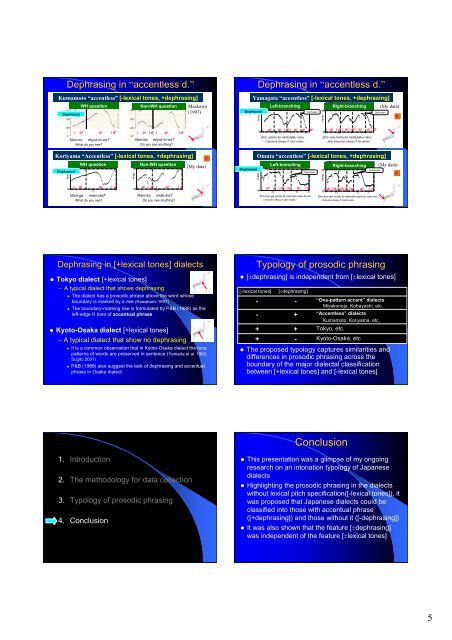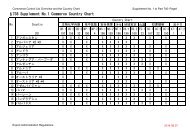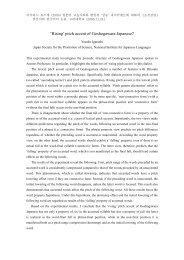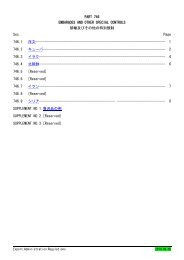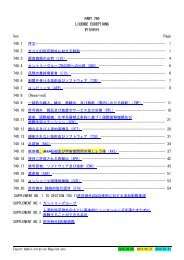Typology of Prosodic Phrasing in Japanese Dialects ... - So-net
Typology of Prosodic Phrasing in Japanese Dialects ... - So-net
Typology of Prosodic Phrasing in Japanese Dialects ... - So-net
You also want an ePaper? Increase the reach of your titles
YUMPU automatically turns print PDFs into web optimized ePapers that Google loves.
Dephras<strong>in</strong>g <strong>in</strong> “accentless d.”<br />
Kumamoto “accentless” [-lexical tones, +dephras<strong>in</strong>g]<br />
WH question<br />
Non-WH question Maekawa<br />
(1997)<br />
Dephrased<br />
Dephras<strong>in</strong>g <strong>in</strong> “accentless d.”<br />
Yamagata “accentless” [-lexical tones, +dephras<strong>in</strong>g]<br />
200<br />
Dephrased<br />
Left-branch<strong>in</strong>g<br />
Dephrased<br />
200<br />
Right-branch<strong>in</strong>g<br />
Dephrased<br />
(My data)<br />
( ω ω )α<br />
Nan-no miyut-to-ne?<br />
What do you see?<br />
( ω )α ( ω )α<br />
Nan-ka miyut-to-ne?<br />
Do you see anyth<strong>in</strong>g?<br />
( ω ω )α ( ω ω )α<br />
50<br />
0.5 1 1.5<br />
Time (sec)<br />
Ziro: yomu-to nemutaku naru.<br />
I become sleepy if Jack reads.<br />
( ω )α ( ω )α ( ω ω )α<br />
50<br />
0.5 1 1.5<br />
Time (sec)<br />
Ziro:-wa nomu-to nemutaku naru.<br />
Jack becomes sleepy if he dr<strong>in</strong>ks.<br />
Koriyama “Accentless” [-lexical tones, +dephras<strong>in</strong>g]<br />
250<br />
Dephrased<br />
WH question<br />
250<br />
Non-WH question<br />
(My data)<br />
Dephrased<br />
280<br />
Omuta “accentless” [-lexical tones, +dephras<strong>in</strong>g]<br />
Left-branch<strong>in</strong>g<br />
Dephrased<br />
280<br />
Right-branch<strong>in</strong>g<br />
Dephrased<br />
(My data)<br />
120<br />
( ω ω ) α ( ω ) α ( ω ) α<br />
0.5 1<br />
Time (sec)<br />
Nani-ga mien-dai?<br />
What do you see?<br />
120<br />
0.5 1<br />
Time (sec)<br />
Nani-ka miek-kai?<br />
Do you see anyth<strong>in</strong>g?<br />
( ω ω )α ( ω ω )α<br />
150<br />
0.5 1 1.5 2<br />
Time (sec)<br />
Ziro:kun-ga yomu-to nemuku naru-te-ne.<br />
I become sleepy if Jack reads.<br />
( ω )α (ω)α (ω ω ) α<br />
150<br />
0.5 1 1.5 2<br />
Time (sec)<br />
Ziro:kun-wa nomu-to nemuku nara-su-mon-ne.<br />
I become sleepy if Jack reads.<br />
Dephras<strong>in</strong>g <strong>in</strong> [+lexical tones] dialects<br />
• Tokyo dialect [+lexical tones]<br />
– A typical dialect that shows dephras<strong>in</strong>g<br />
• The dialect has a prosodic phrase above the word whose<br />
boundary is marked by a rise (Kawakami 1957)<br />
• The boundary-mark<strong>in</strong>g rise is formulated by P&B (1988) as the<br />
left-edge H tone <strong>of</strong> accentual phrase<br />
• Kyoto-Osaka dialect [+lexical tones]<br />
– A typical dialect that show no dephras<strong>in</strong>g<br />
• It is a common observation that <strong>in</strong> Kyoto-Osaka dialect the tone<br />
patterns <strong>of</strong> words are preserved <strong>in</strong> sentence (Yamada et al. 1982;<br />
Sugito 2001)<br />
• P&B (1988) also suggest the lack <strong>of</strong> dephras<strong>in</strong>g and accentual<br />
phrase <strong>in</strong> Osaka dialect<br />
<strong>Typology</strong> <strong>of</strong> prosodic phras<strong>in</strong>g<br />
• [±dephras<strong>in</strong>g] is <strong>in</strong>dependent from [±lexical tones]<br />
[±lexical tones]<br />
-<br />
-<br />
+<br />
+<br />
[±dephras<strong>in</strong>g]<br />
-<br />
+<br />
+<br />
-<br />
“One-pattern accent” dialects<br />
Miyakonojo, Kobayashi, etc.<br />
“Accentless” dialects<br />
Kumamoto, Koriyama, etc.<br />
Tokyo, etc.<br />
Kyoto-Osaka, etc<br />
• The proposed typology captures similarities and<br />
differences <strong>in</strong> prosodic phras<strong>in</strong>g across the<br />
boundary <strong>of</strong> the major dialectal classification<br />
between [+lexical tones] and [-lexical tones]<br />
Conclusion<br />
1. Introduction<br />
2. The methodology for data collection<br />
3. <strong>Typology</strong> <strong>of</strong> prosodic phras<strong>in</strong>g<br />
4. Conclusion<br />
• This presentation was a glimpse <strong>of</strong> my ongo<strong>in</strong>g<br />
research on an <strong>in</strong>tonation typology <strong>of</strong> <strong>Japanese</strong><br />
dialects<br />
• Highlight<strong>in</strong>g the prosodic phras<strong>in</strong>g <strong>in</strong> the dialects<br />
without lexical pitch specification([-lexical tones]), it<br />
was proposed that <strong>Japanese</strong> dialects could be<br />
classified <strong>in</strong>to those with accentual phrase<br />
([+dephras<strong>in</strong>g]) and those without it ([-dephras<strong>in</strong>g])<br />
• It was also shown that the feature [±dephras<strong>in</strong>g]<br />
was <strong>in</strong>dependent <strong>of</strong> the feature [±lexical tones]<br />
5


